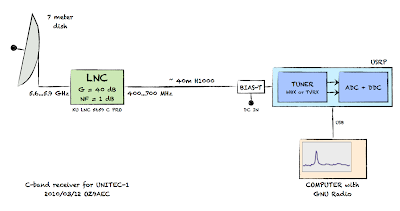This weekend I ended up receiving APT signals from NOAA polar orbiting weather satellites. I only wanted to explore IQ data recording and playback with GNU Radio but when I first used NOAA 15 as test signal and saw what I could receive I got slightly distracted from my original plan.
USRP
5.8 GHz Helical Feed for the 90cm dish
Yesterday was day 2 where we were repairing the broken Azimuth rotator and making a small 90cm dish ready to track UNITEC-1 on 5.84 GHz. Actually, we already fixed the rotator on Monday but we ended up mounting it 180° off and we decided to fix it properly instead of just correcting it in software.
Fixing the orientation of the Azimuth rotoator was very quick – it took only 17 minutes to get up to the mast, lift the antenna construction, change the orientation of the rotator and fasten the nuts and bolts again. We had the practice from yesterday.
Next item on the agenda was to make a small helix with two turns to feed the 90cm dish so that we can use this smaller dish for tracking UNITEC-1 in the beginning of the interplanetary cruise. We found some online helical antenna calculator to generate the design but that was more than 1 GHz off and it took a lot of tweaking and tuning to get it close to 5.8 GHz. Here are the results, photos and videos.
C-band Receiver Hardware for UNITEC-1
With only a few days left until the launch of UNITEC-1 (May 17) to Venus, we are getting ready to track it and I am trying to catch up on the documentation part – this time a brief description of the receiver hardware.
Recall the system architecture where the 5.84 GHz RF signal is converted to 640 MHz using the KU LNC 5659 C PRO low noise down converter, and…
This article gives a high level walkthrough of the receiver used to convert the 640 MHz IF to digital baseband, i.e. the blue box called USRP in the above diagram.
GRC Examples
On this page you will find a few software defined radio (SDR) examples implemented in the GNU Radio Companion aka GRC. They are very simple yet functional examples I created while I was learning GNU Radio and SDR. I hope other who are learning GNU Radio and SDR might also find them useful.
SSTV Robot OZ9STV with USRP and WBX
I was fooling around with the USRP / WBX on the 2 meter band tonight when I suddenly stumbled upon some very strong SSTV transmission. It turned out to be the OZ9STV robot located only a few kilometers from me. That explained why I had more than 40 dB SNR even though I was only using a bad whip antenna indoors.
UNITEC-1 5.8 GHz Receiver Test Using OZ7IGY
![]()
Tuesday, April 13, 2010 we finally got a chance to test the 5.8 GHz receiver for the UNITEC-1 ground station on the air. The weather was nice and the weak wind allowed us to be on the roof and listen for the OZ7IGY beacon 40 km away.
GNU Radio SSB/CW/AM/FM Receiver v0.6
New update of the simple receiver – version 0.6 – with the following changes:
- Added frequency entry widget to change USRP frequency
- Also created AM and narrow FM versions
Binaural CW Receiver with GNU Radio and USRP
Today I felt like doing an experiment that is not quite on my TODO list – a binaural CW receiver. A binaural CW receiver is a receiver that gives a spatial feeling while you are tuning. As I understand it, you have to use stereo where the signals move from one side to the other as you tune and are in the middle when you are tuned to the frequency.
Improved AGC for the simple SSB receiver
Few days ago I wrote about how I upgraded the simple double side band receiver implemented in the GNU Radio Companion to a simple single side band receiver. This initial implementation used some default values for the AGC attack and decay rates. These values were acceptable; however, I wanted to spend some time trying to find better values that would correspond to Fast, Medium and Slow AGC – just as we are used to in commercial radios.
Simple SSB Receiver in GNU Radio Companion
The simple SSB software defined radio receiver is now functional!
Few days ago I wrote about how to upgrade the simple double side band receiver to single side band. The modification was supposed to be very simple and involved changing the band pass filter from using real taps to use complex taps. The upgrade wasn’t quite as easy, though.
